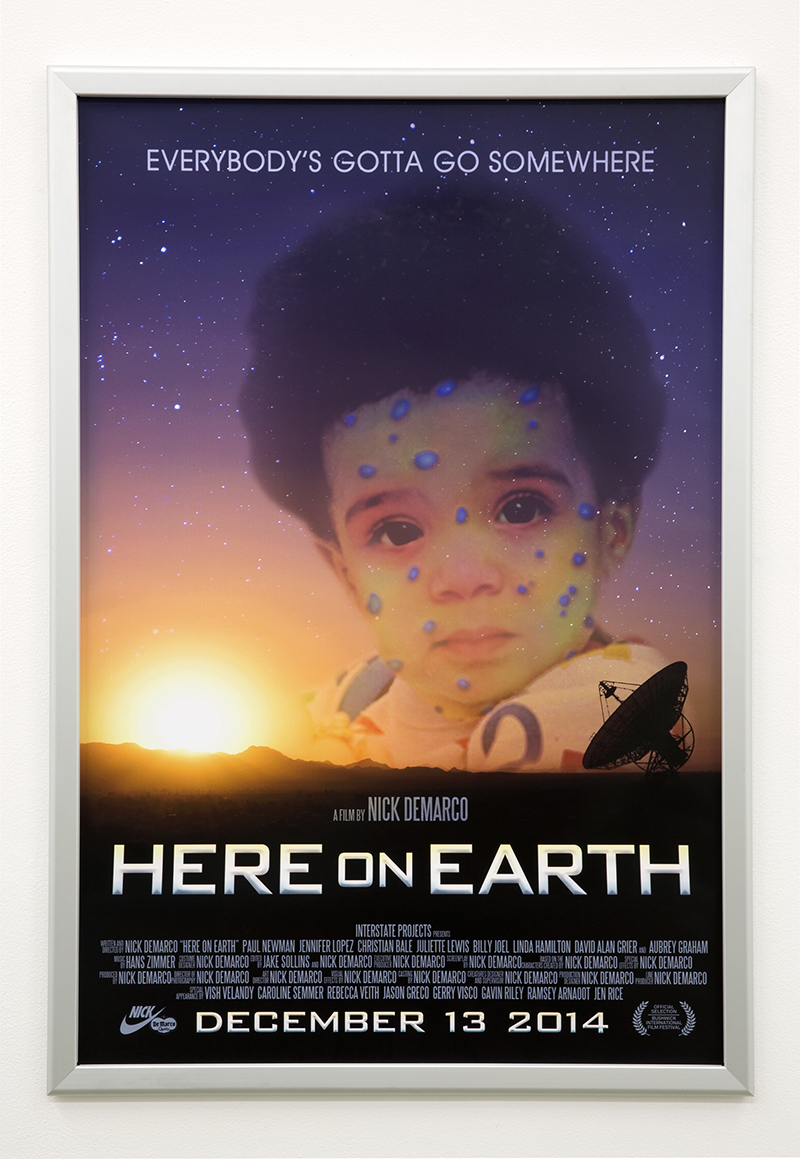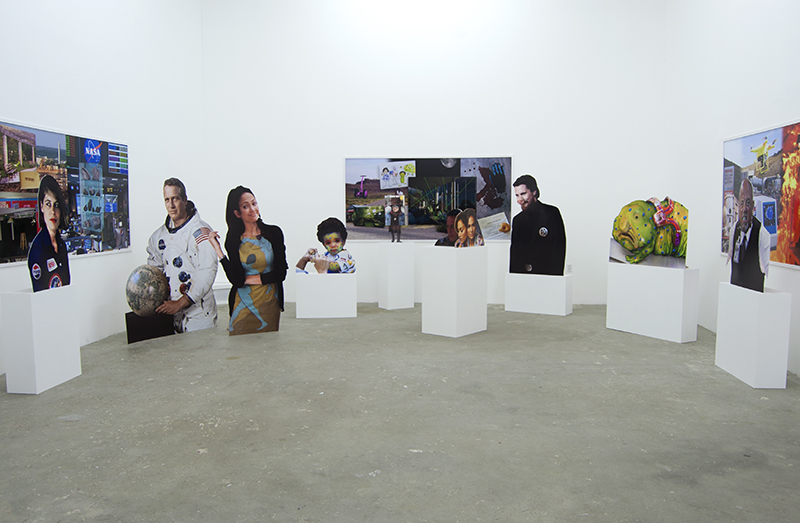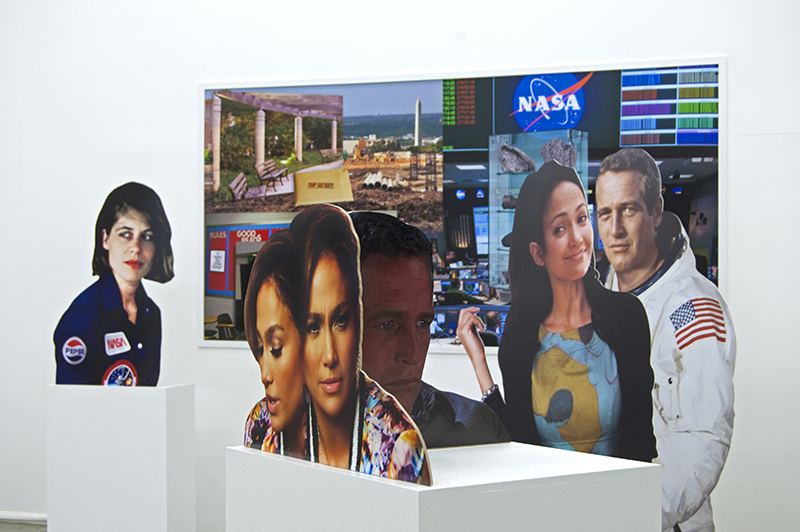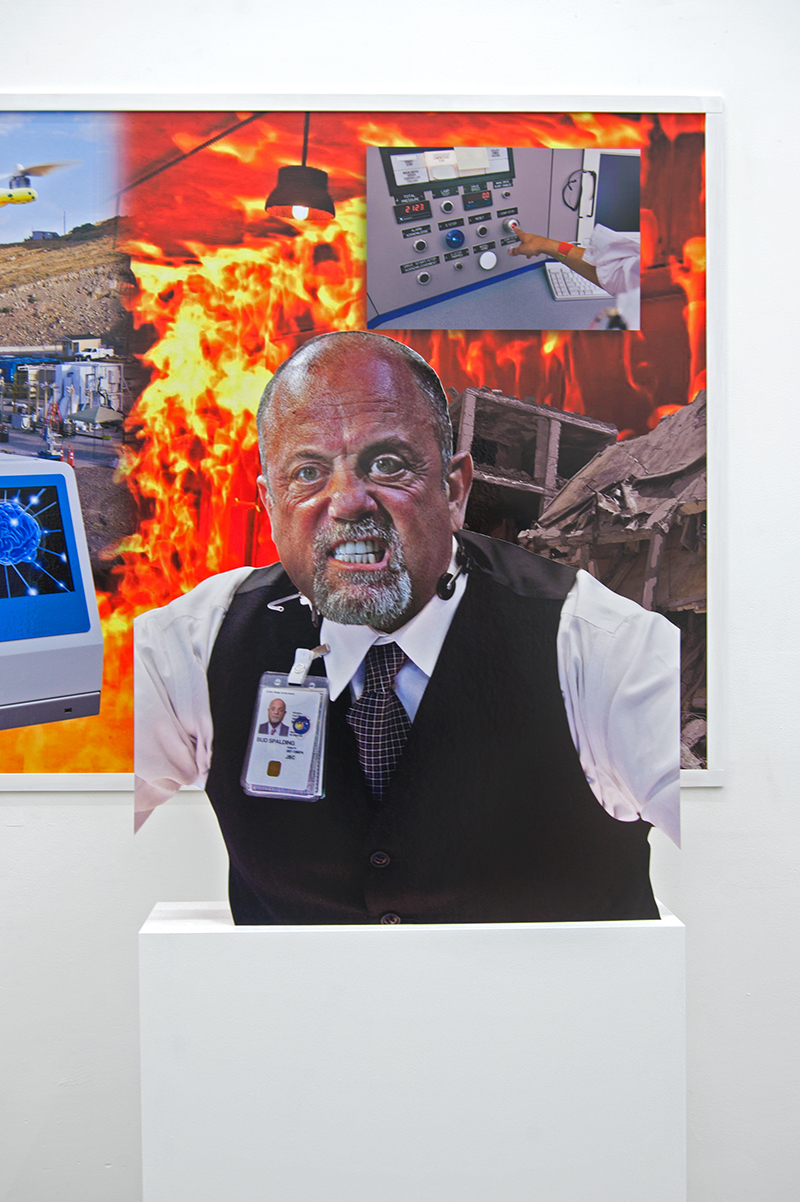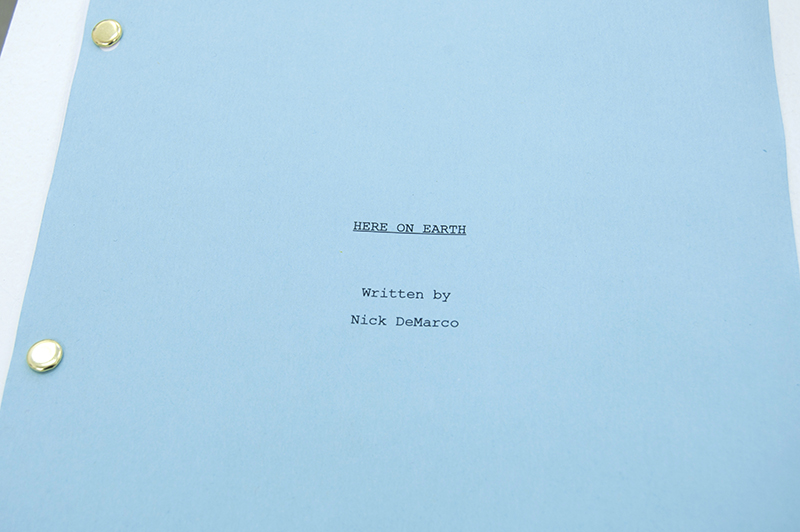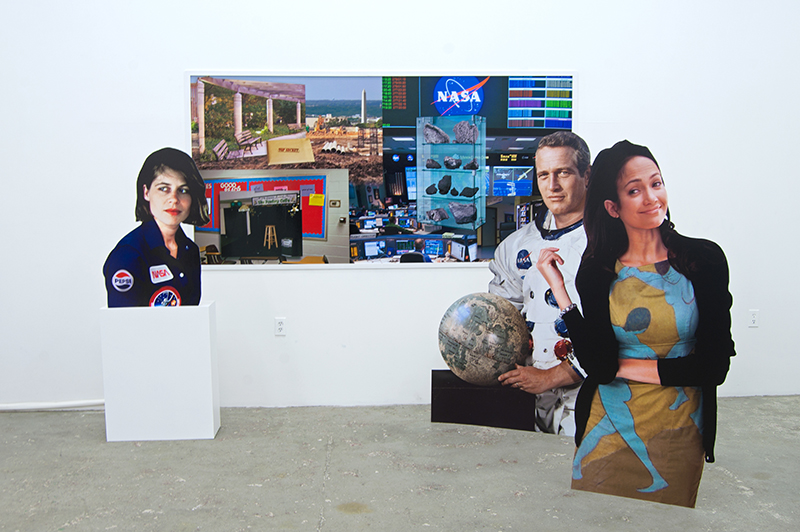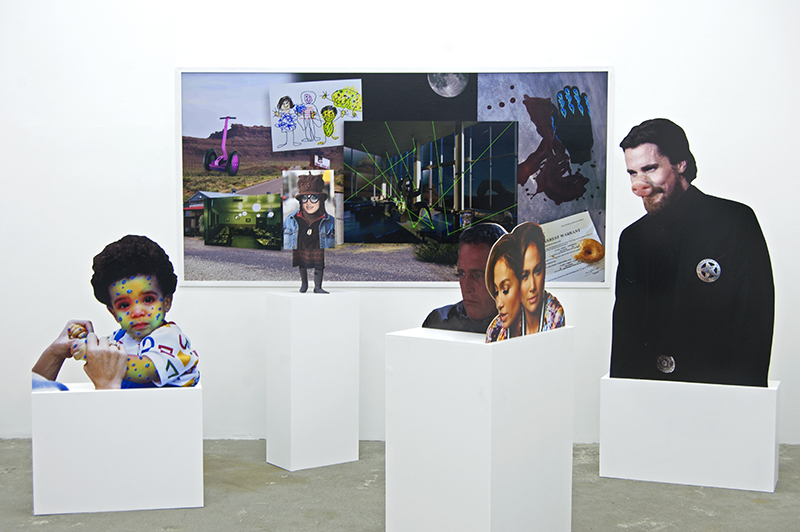Lafayette Anticipation associate curator Anna Colin talks to artist Tyler Coburn about Ergonomic Futures, a speculative project engaged with art, design, science, anthropology and writing. In this interview, Coburn discusses the research, production process and network of collaborators of a multilayered project ultimately concerned with the futures of humankind. Anna Colin: When one comes across your museum seats Ergonomic Futures (2016—) in contemporary art exhibitions—and soon in natural history, fine art, and anthropology museums—they look… [read more »]
Here On Earth | Nick DeMarco
Nick DeMarco’s Here on Earth is currently on view at Interstate Projects in Brooklyn, NY through February 1st. The show is part feature film, part sculptural installation, creating an enjoyably convergent experience. DeMarco casts cut-outs of celebrities including main characters Jennifer Lopez, Paul Newman, and baby Drake into a narrative that is equal parts science fiction, government conspiracy, and family drama. The plot is enforced by a soundtrack full with foley, music, and hired voice actors from Craigslist taking on the roles of the celebrity cut-outs.
We talked with Nick about script writing, Craigslist casting, and making his first “blockbuster” film without moving images.
Nic Burrier: I had a lot of fun seeing the show. How did the project develop?
Nick DeMarco: Yeah sure, the idea was that I wanted to make a blockbuster feature film, but I wanted to make it all by myself, with sculptures and audio in a gallery. Extending that a little bit, I wanted to use photoshopped images, and make them sculptural. So I, in a way, wanted to merge different interests of mine: physical production, digital image, and writing. This project was a way to thread them all together. The idea was that I was going to make a blockbuster feature film, so I wrote a feature length screenplay, it’s 120 something pages, and I got actors from Craigslist, friends of friends, other random people. I got them to come in and record the different characters, and then I went in and did all the sound design, I put in footsteps, I put in sound effects, I put in music. All that kind of stuff. So I made this two hour long feature length audio track. And I cast it with A list actors, like my ideal actors if I were really going to be able to make a movie. I cast it with Paul Newman and Jennifer Lopez as the two leads, Drake when he was a little baby plays one of the central characters, he’s their son. He’s also half human half alien.
NB: I just drove through Roswell, NM a couple weeks ago, so it was pretty fun to hear it surface in the story.
ND: Oh really? I’ve always wanted to go there. Is there a bunch of plaster aliens and stuff?
NB: Ya, it’s like, even the CVS there has a giant alien image posted on the front of the building. It’s pretty insane. The plot of your “blockbuster” was really important to the piece, where did the story come from?
ND: Um, well you know. The muse floated down, and landed on my shoulder, whispered some ideas, ha. I mean it was an interesting exercise for me, because I really love to write, but I had never really done a long form fiction like that. My original way of framing it was to tie in different interests I have. So I’ve always loved conspiracies and aliens, so I wanted that to be a central idea. And then I wanted to get some political issues of the time that I think are interesting, like privatization, and censorship. I was working with A list actors, and I wanted to put them in situations they might not normally be in. The idea of making J Lo a transgressive poet was really cool to me. So it was kind of a combination of things, and then, in writing it I wanted to walk that line between satire and genuine embrace of the thing. So I wanted it to be like, is this all a joke, but at the same time, I wanted the family to be a real family unit, and I wanted there to be some real moments of heart despite the general absurdity of the thing.
NB: So what was the process of hiring the Craigslist actors?
ND: The voices were definitely the most difficult part of the project, and that was something that I didn’t really adequately foresee how difficult that would be. It ended up being great, the actors I got were great. But finding someone on Craigslist, I was under the impression there were more actors who were interested in doing weird projects like this. So I was able to find some, but there weren’t that many people hitting me up. The guy who plays Billy Joel, he was great, he was from New Jersey, and he was super game. I made it very clear to him that this is a movie, but it’s not exactly a movie. I didn’t want to lie to people and tell them it was a movie and it actually wasn’t going to be. You know, I’m making a movie but it’s a little different. He was like sure, sure, you know, he was on board. I mean you heard in the thing, he has this great, just like, dude voice.
NB: Yeah, I felt like the voices were really well matched to the celebrities you chose.
ND: Yeah, I never told the actors to do an impression. I knew who they were playing beforehand, like when I was casting the voices I said a Paul Newman type character, a Jennifer Lopez type character. But I never said do an impression of Jennifer Lopez. I fit the celebrity characters to the role more than the actor.
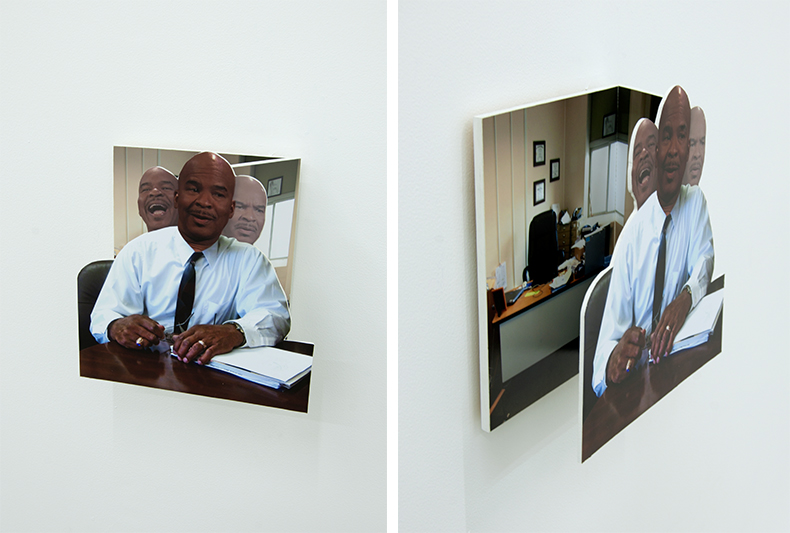
Nick DeMarco, David Allen Grier as Glenn Ross, 2014, digital print, plywood, 13 x 14 1⁄2 x 5 3⁄4 inches
NB: What interested you about juxtaposing voice actors hired from Craigslist with images of celebrities? You decided to create fictional characters using the images of celebrities that everyone knows rather than creating an entirely new identity.
ND: There’s a few elements that I liked about the whole idea, from a very baseline, why I wanted to make a movie at all is just sort of the idea that movies are the default language that we understand the world, so it was coming from a very populist standpoint. I love the fact that people will see a movie and like really think of the different parts of it; they’ll have an art conversation about movies and not even know it. People have these conversations about movies in a way they never would if they went to see a painting show at the local museum. I love that idea about movies, and so I wanted to sort of take that populist energy and then make a movie myself in this kind of scrappy, but hopefully still polished way. So the idea of using Craigslist actors, I mean it wasn’t integral to the idea, if I could have used A list actors, that would have been awesome, but I do like the idea of using Craigslist actors because it sort of gets into the populist ideas.

Nick DeMarco, Juliette Lewis as Deb Fleishman, 2014, digital print, board, wood, 62 x 17 x 9 3⁄4 inches
NB: Yeah, as you’re talking about the way we connect with feature length film, I’m realizing that a fair amount of your work seems to approach these larger systems with predefined rules, like your work within design. At the same time it definitely yields a subversion. To me this piece kind of questions or even diversifies an understanding of narrative through embodying it.
ND: Yeah I’m glad you picked up on that. That was definitely something I was interested in, because like you said, I like systems, and I like rearranging them. So to make a movie I knew I had to do it in a different way. I wanted to think critically about narrative but also about sculpture. I was thinking about it as a movie just as much as I was thinking about it as sculpture. So I wanted to organize it in a way where it could be viewed as narrative sculpture or as a physical movie at the same time. I wanted to balance those two things. I was interested in what happens if you’re inside a movie, you know. Can I take the parts of a movie, you know add someone’s basic image, and sound, and can I somehow create that effect that you get when you watch a movie, because you know, when a movie comes together perfectly, in my opinion, there isn’t really any sweeter experience artwise. Like, the music swells, when the editing is just perfect, that just hits you so well. It’s almost more effective in a way than most other art experiences. I wanted to give some semblance of that feeling through sculptures.
NB: Your use of sculpture in this was interesting to me. You continue to enforce the two dimensional plane of a screen, even as you brought these characters out into the space. They remained two dimensional, as cut-outs.
ND: Yeah, that’s definitely part of it. You know, there are those three tableaus. I divided the movie up into three acts of a story, and I made these wall graphics that contained all the settings that happen within that act of the movie. Then putting them on the wall was screenlike, and most of the characters are arranged at the height of the screen, so it was essentially like recreating the screen experience without any technology. I guess that was sort of more what I was saying earlier about how I have different ends of my practice where some things are extremely digital, and can only exist on a screen. And some things aren’t digital at all. It’s something I’ve been trying to do for a long time, to have a show, in a gallery, that was all photoshop. This is the closest I’ve come to doing that.
NB: Cool, yeah I think another really important part of the piece that we haven’t yet talked about yet is the humor, and I think there’s also humor in a lot of your other work.
ND: Yeah, that’s definitely true, and its something I always try to maintain. It’s hard with art, because, I think if you start going down the path of humor and art then suddenly it becomes about humor, it becomes an analysis of humor, which I really am not interested in at all. Like really that’s the best way to kill a joke, to analyze it. For a while I’ve been trying to figure out ways to make funny art that isn’t a joke. With this piece, it’s kind of like what I was saying earlier, I wanted to walk that line between satire and real emotion, so I wasn’t afraid to make it as absurd as possible, but I also wanted to keep it grounded in something. You know, not just be a complete joke, but the absurdity of the whole experience, I wanted it to be funny. You know like seeing Billy Joel screaming as he’s engulfed in flames, to me, was so funny. I was losing my mind during the install, Billy Joel was one of the first ones I got up on a pedestal while I was cutting out the other ones. And I was just cracking up in the gallery, I would walk up to him and go like AHHH, you know like that energy just keeps me going.
NB: Haha yeah, totally. I guess something else that I picked up on that was interesting, I think this is present in a lot of your furniture too, is this appeal to some sort of subjectivity, if even just by defying normative design. I think that was present in this piece too, as it was giving a fair amount of agency to the viewer’s subjectivity. Since a lot of visual components are intentionally omitted I found myself putting my own visuals into the story, or my own thoughts, more than I would with a “normal” feature length piece. I guess I was wondering what you thought about that possibility for a different level of engagement from the audience.
ND: Yeah, I’m glad to hear you say that. The whole thing is such an experiment for me. When I was setting up the show, people were asking me, how do you want people to view this, do you want them to sit and watch the whole two hours, or do you want them to just pass through, and the answer is that I really don’t know what I want people to do because I’ve never done anything like this before. So to hear that you were engaging with it is nice. That is definitely what I would have liked, I went through frame by frame to find the perfect screenshot that I thought really had some emotion that could be pasted onto multiple moments in the story. Like that one sculpture of brooding Paul Newman, I wanted that to be multiple moments, you know, not one specific moment in the story when he’s upset. I wanted that to be sort of what you’re saying, fill in the blanks. Part of that is that the text was a big part of it to me also. So I wanted the text to be present, and the great part of text is that you get the story in your mind.
NB: Yeah, it’s a blend of sculpture and film, it rides the line, especially with the specific showtimes set up for the audience to view it. In my experience that’s normally reserved for more performance-based pieces, but of course this piece does have elements of that.
ND: Yeah that’s kind of what I was talking about. I wanted it very much to be sculptural, and for it to be a full experience as well. I’m glad you got to see it in person, because the way it gets animated is that you’re moving through the space. With the cut-outs it changes as you move around; the scale changes, there is movement in the movie. So I wanted it to be an experience more than a bastardization of a movie. I didn’t want it to just be like, well I’m making a movie but I don’t have any money so I’ll just do it with cut-outs. I wanted it to be very deliberate, like this is designed to be what it is, it’s not a stand in for what I’d want it to be. The whole time I was organizing it around it being an experience in a gallery.
Cast of Voices:
Jen Rice
Jason Greco
Vishwam Velandy
Caroline Semmer
Jonathan Coward
Borna Sammak
Nick DeMarco
Adrienne Humblet
Jake Sollins
Isabel Martin
Rebecca Veith
Ramsey Arnaoot
Gavin Riley
Geraldine Visco
More about Nick DeMarco
